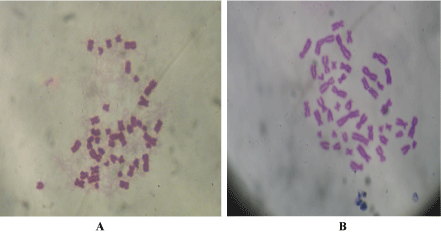Chewing of betel quid (BQ) and areca nut is an ancient custom in South East Asia. The International Agency for Research on Cancer has listed betel quid as group 1 carcinogenic agents to humans , which have role in multistage progression in oral squamous cell carcinoma.Oral squamous cell carcinoma are characterized by complex karyotype that involve many chromosomal aberration(CA) with higher mitotic index a in cancer and pre cancer (both betel quid and non betel quid chewers) cases than normal. The present review focuses on carcinogenic effects of betel quid on human chromosome associated with betel quid chewers.
chromosomal aberration (CA), mitotic index (MI), betel quid (BQ), oral squamous cell carcinoma (OSCC)
Around 6 million people die from tobacco use andsecond-hand smoke. The prevalence of smoking among men ishigher in lower-middle income countries whereas for the total population; it is higher in upper-middle income countries [1]. In India, tobacco problem is more complex than probably any other country in the worldbecause of the various patterns of tobacco consumption like chewing, smoking, applying, sucking, gargling and a large consequential burden of tobacco-related diseases and death [2]. Incidence of tobacco related cancers like lips tongue, mouth, lungs, oropharynx etc. may also increase during 2015–2025 [3].
Populations with high chewing rates often have a higher incidence rate of oral and pharyngeal cancers than other countries. In BQ endemic areas, a close association is observed between a higher prevalence of BQ chewing and the age standardizedrate adjusted by the world population (ASRW) for the incidence / mortality rate of oral and pharynx cancers. In some countries (e.g., Malaysia [4] and Thailand [5], the intermediate proportion of BQ use may result in anintermediate incidence of oral and pharyngeal cancers. No BQ chewing habits in some countries, such as Singapore, Japan, and Korean.
Rate of BQ use was higher (57.7%) in Papua New Guinea, 62.8% for men and 52.8% for women [6]. In a large-scale survey, the proportion of BQchewers was 45.2%, 54.0% for men and 42.0% for women, respectively [7]. In Sri Lanka, a large-scale survey, the proportion of BQ chewers was 45.2%, 54.0% for men and 42.0% for women, respectively [7]. In Myanmar a n early report indicated that 24.5% were BQchewers (combine 16.2% regular chewers with 8.3% occasional chewers) [8]. In Pakistan, the incidence (2012 ASRW) of oraland pharyngeal cancers was 13.5 per 100,000 men and 13.2 per 100,000 women. There was a high proportion of BQ use andan elevated incidence rate of cancers of oral and pharynx in Pakistan. In Nepal. Recently, the national population-based survey reported that the prevalence of BQ chewers was 40.7% (43.6% for men and 34.9% for women) [9]. Recently, in a population-based study conducted among Cambodiaadults, 19.7% of women indulged in the BQ habits [10].
Areca alkaloids (arecoline and arecaidine) are the major causes of toxicity from AN. The IARC points out that arecoline has limited evidence for carcinogenicity in animal experiments and arecaidine has inadequate evidence in animal experiments [9]. In mammalian cells, arecoline and arecaidine can causebacterialmutagenicity, and in vitro and in vivo tests can result in the exchange of sister chromatid, aberrations of chromosome [4].

Figure 1. (A) Human chromosomal abberration (Aneuploidy) (B) No chromosmal abberration
Chromosomal instability (CI) or chromosomal aberration (CA) is a crucial genetic event in OSCC and also in its precursors as an initial neoplastic substrate found as abnormal numerical alterations, such as polysomy / aneuploidy (usually 3-5 chromosome copies per nucleus) and monosomy (loss of one chromosome) . Chromosomes 1, 3, 4, 5, 7, 8, 9, 11, 14, 18, 19, 20 are predominantly implicated in the carcinogenetic process and also in an aggressive malignant phenotype [11].
In this study total 311 subjects screened from different parts of India mainly betel quid chewers(> 73%),) with leukoplakia(> 9%), erythrplakia(> 7%),) and OSCC(> 15.7%). Mitotic index are higher in cancer and pre cancer cases with betel quid chewing habit than normal. Percentage of chromosomal aberration (CA) is also higher with chromatid break with aneuploidy.
- WHO. Global Status Report on Non-communicable Diseases 2010. vol. 2011. Geneva.
- Sinha D (2012) Report on Global Youth Tobacco Survey (GYTS) 2002, Uttar Pradesh, India.
- Prasad JB, Dhar M (2018) Projections of burden of cancers: a new approach for measuring incidence cases for India and its states–Till 2025. Journal of cancer policy 16:57-62.
- World Health Organization and International Agency for Research on Cancer (IARC) (2004) Betel-Quid and Areca-Nut Chewing and Some Areca-Nut-Derived Nitrosamines, vol. 85 of IARC Monographs on the Evaluation of Carcinogenic Risks to Humans.
- Reichart PA, Mohr U, Srisuwan S, Geerlings H, Theetranont C, Kangwanpong T (1987) Precancerous and other oral mucosal lesions related to chewing, smoking and drinking habits in Thailand. Community Dentistry and Oral Epidemiology 15(3):152-160.
- Pindborg JJ, Barmes DOD, Roed-Petersen B (1968) Epidemiology and histology of oral leukoplakia and leukoedema among Papuans and New Guineans. Cancer 22(2):379-384.
- Warnakulasuriya KAAS (1992) “Smoking and chewing habits in Sri Lanka: implications for oral cancer and precancer,” in Control of Tobacco-Related Cancers and Other Diseases, P. C. Gupta, J. E. Hamner III, and P. R. Murti, Eds., pp. 113–118, Oxford University Press, Mumbai, India.
- Reichart PA, Way TH (2006) Oral cancer and pre-cancer in Myanmar: a short review. Journal of Oral Pathology & Medicine 35(4):193-196.
- Lee CH, Ko AM, Warnakulasuriya S (2011) Intercountry prevalences and practices of betel-quid use in south, southeast and eastern asia regions and associated oral pre neoplastic disorders: an international collaborative study by asian betel quid consortium of south and east Asia. International Journal of Cancer 129(7):1741-1751.
- Chher T, Hak S, Kallarakkal TG (2016) Prevalence of oral cancer, oral potentially malignant disorders and other oral mucosal lesions in Cambodia. Ethnicity & Health 1-15.
- Kallionemi A (1992) Comparative genomic hybridization for molecular cytogenetic analysis of solid tumours. Science 258: 818-21.

